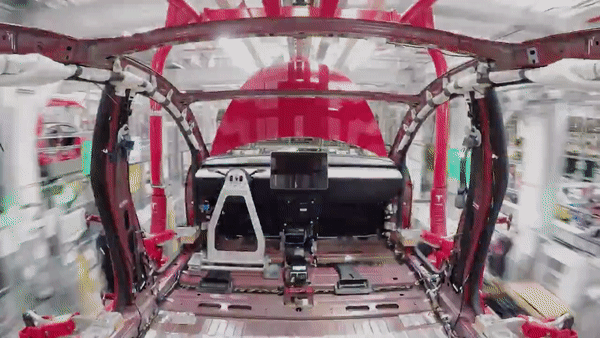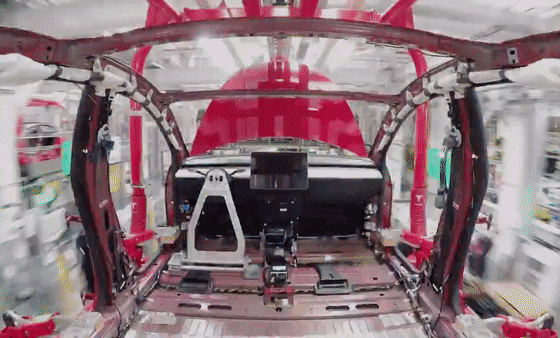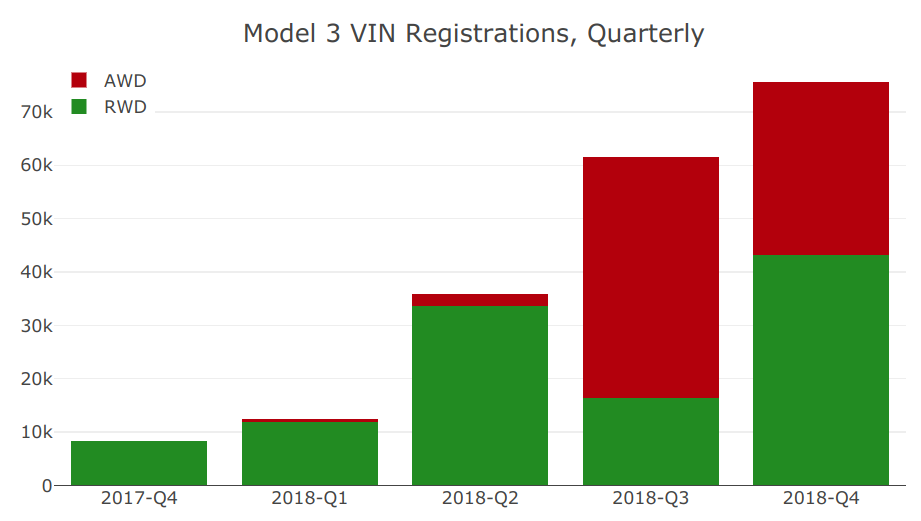

Investor's Corner
Tesla ends Q4 2018 with a flourish, passes 190k total Model 3 VIN registrations
Tesla started 2018 as an electric car maker struggling to ramp the production of its most ambitious vehicle. As Q4 2018 comes to a close, it is becoming apparent that Tesla is closing the year as a carmaker that can hold its own against the veterans of the hyper-competitive auto industry. Seemingly as a final flourish to an otherwise historic 2018, Tesla has registered what could very well be its final large batch of Model 3 VINs for the quarter, breaching the 190,000 barrier for filings of the electric sedan.
#Tesla registered 3,569 new #Model3 VINs. ~52% estimated to be dual motor. Highest VIN is 193556. https://t.co/ezA2Bas4Kh
— Model 3 VINs (@Model3VINs) December 30, 2018
Twitter group @Model3VINs, which tracks registrations for the electric sedan, recently reported that Tesla filed a rather large batch of 3,569 vehicles, comprised of both Dual Motor and RWD units. With this latest batch, Tesla has broken the 190,000 mark in total Model 3 filings to date. Among this number, more than 75,000 were registered in the fourth quarter alone. As noted by this graph provided by the Model 3 VIN tracking group, the Q4 2018 is characterized by a massive influx of RWD filings, possibly as a result of the introduction, production, and deliveries of the Mid Range Model 3.

To keep the company’s Q4 Model 3 VIN registrations in perspective, it should be noted that Tesla was only able to breach the 75,000 mark back in mid-July, roughly a year since starting the production of the vehicle. For a company that encountered hiccups with the Model 3 ramp, being able to register 12 months worth of cars in the past 90 days is impressive.
Tesla’s Model 3 VIN registrations for the fourth quarter comes amidst reports that the company has reached a point where it is capable of producing 1,000 units of the electric sedan every day. As reflected by an alleged leaked email from Elon Musk late last month, as well as by social media posts from Tesla employees in the days and weeks after, it appears that the company’s Model 3 output continues to improve.
https://twitter.com/VickiSalvador/status/1074397006318120960
With Tesla at a point where it is capable of sustained levels of Model 3 production, the company is now starting to lay the foundations for the electric sedan’s international ramp in 2019. In Europe, for one, reports have emerged pointing to Tesla shipping 3,000 Model 3 per week starting in February. Deliveries of the Model 3 in China are also expected to begin within the next few months.
At the core of the Model 3, though, lies the vehicle and its demand. In several key regions such as the United States, after all, the Model 3 competes in a market that widely prefers SUVs and larger vehicles. Nevertheless, as the electric sedan’s sales in the US and Canada have shown so far, the Model 3 is capable of standing out despite being a passenger car in an SUV dominated region.
As the Model 3 prepares to breach the foreign markets, Wall Street analyst Dan Ives from Wedbush Securities noted that demand for the vehicle would likely be strong in 2019. According to the analyst, the demand for the car in regions such as Europe — which still have notable passenger car markets — would likely reduce Tesla’s need to raise capital in the near future.
“Demand for Tesla’s Model 3 mid-size electric sedan looks very strong into 2019 and beyond. While there are worries that some European unit shipments might spill over into Q2 and out of Q1, we believe the Street is well aware of this potential timing dynamic as underlying pent-up demand looks robust on this new European frontier for Musk & Co heading into 2019, with China also a major growth catalyst on the heels of recent price cuts,” the analyst wrote.
As a cherry on top for the already successful vehicle, the Model 3 recently received the 2018 Car of the Year award from The Detroit News, with longtime gearhead Henry Payne stating that the electric sedan is “Apple on wheels.”

Investor's Corner
Tesla stock closes at all-time high on heels of Robotaxi progress

Tesla stock (NASDAQ: TSLA) closed at an all-time high on Tuesday, jumping over 3 percent during the day and finishing at $489.88.
The price beats the previous record close, which was $479.86.
Shares have had a crazy year, dipping more than 40 percent from the start of the year. The stock then started to recover once again around late April, when its price started to climb back up from the low $200 level.
This week, Tesla started to climb toward its highest levels ever, as it was revealed on Sunday that the company was testing driverless Robotaxis in Austin. The spike in value pushed the company’s valuation to $1.63 trillion.
Tesla Robotaxi goes driverless as Musk confirms Safety Monitor removal testing
It is the seventh-most valuable company on the market currently, trailing Nvidia, Apple, Alphabet (Google), Microsoft, Amazon, and Meta.
Shares closed up $14.57 today, up over 3 percent.
The stock has gone through a lot this year, as previously mentioned. Shares tumbled in Q1 due to CEO Elon Musk’s involvement with the Department of Government Efficiency (DOGE), which pulled his attention away from his companies and left a major overhang on their valuations.
However, things started to rebound halfway through the year, and as the government started to phase out the $7,500 tax credit, demand spiked as consumers tried to take advantage of it.
Q3 deliveries were the highest in company history, and Tesla responded to the loss of the tax credit with the launch of the Model 3 and Model Y Standard.
Additionally, analysts have announced high expectations this week for the company on Wall Street as Robotaxi continues to be the focus. With autonomy within Tesla’s sights, things are moving in the direction of Robotaxi being a major catalyst for growth on the Street in the coming year.
Elon Musk
Tesla needs to come through on this one Robotaxi metric, analyst says
“We think the key focus from here will be how fast Tesla can scale driverless operations (including if Tesla’s approach to software/hardware allows it to scale significantly faster than competitors, as the company has argued), and on profitability.”

Tesla needs to come through on this one Robotaxi metric, Mark Delaney of Goldman Sachs says.
Tesla is in the process of rolling out its Robotaxi platform to areas outside of Austin and the California Bay Area. It has plans to launch in five additional cities, including Houston, Dallas, Miami, Las Vegas, and Phoenix.
However, the company’s expansion is not what the focus needs to be, according to Delaney. It’s the speed of deployment.
The analyst said:
“We think the key focus from here will be how fast Tesla can scale driverless operations (including if Tesla’s approach to software/hardware allows it to scale significantly faster than competitors, as the company has argued), and on profitability.”
Profitability will come as the Robotaxi fleet expands. Making that money will be dependent on when Tesla can initiate rides in more areas, giving more customers access to the program.
There are some additional things that the company needs to make happen ahead of the major Robotaxi expansion, one of those things is launching driverless rides in Austin, the first city in which it launched the program.
This week, Tesla started testing driverless Robotaxi rides in Austin, as two different Model Y units were spotted with no occupants, a huge step in the company’s plans for the ride-sharing platform.
Tesla Robotaxi goes driverless as Musk confirms Safety Monitor removal testing
CEO Elon Musk has been hoping to remove Safety Monitors from Robotaxis in Austin for several months, first mentioning the plan to have them out by the end of 2025 in September. He confirmed on Sunday that Tesla had officially removed vehicle occupants and started testing truly unsupervised rides.
Although Safety Monitors in Austin have been sitting in the passenger’s seat, they have still had the ability to override things in case of an emergency. After all, the ultimate goal was safety and avoiding any accidents or injuries.
Goldman Sachs reiterated its ‘Neutral’ rating and its $400 price target. Delaney said, “Tesla is making progress with its autonomous technology,” and recent developments make it evident that this is true.
Investor's Corner
Tesla gets bold Robotaxi prediction from Wall Street firm
Last week, Andrew Percoco took over Tesla analysis for Morgan Stanley from Adam Jonas, who covered the stock for years. Percoco seems to be less optimistic and bullish on Tesla shares, while still being fair and balanced in his analysis.

Tesla (NASDAQ: TSLA) received a bold Robotaxi prediction from Morgan Stanley, which anticipates a dramatic increase in the size of the company’s autonomous ride-hailing suite in the coming years.
Last week, Andrew Percoco took over Tesla analysis for Morgan Stanley from Adam Jonas, who covered the stock for years. Percoco seems to be less optimistic and bullish on Tesla shares, while still being fair and balanced in his analysis.
Percoco dug into the Robotaxi fleet and its expansion in the coming years in his latest note, released on Tuesday. The firm expects Tesla to increase the Robotaxi fleet size to 1,000 vehicles in 2026. However, that’s small-scale compared to what they expect from Tesla in a decade.
Tesla expands Robotaxi app access once again, this time on a global scale
By 2035, Morgan Stanley believes there will be one million Robotaxis on the road across multiple cities, a major jump and a considerable fleet size. We assume this means the fleet of vehicles Tesla will operate internally, and not including passenger-owned vehicles that could be added through software updates.
He also listed three specific catalysts that investors should pay attention to, as these will represent the company being on track to achieve its Robotaxi dreams:
- Opening Robotaxi to the public without a Safety Monitor. Timing is unclear, but it appears that Tesla is getting closer by the day.
- Improvement in safety metrics without the Safety Monitor. Tesla’s ability to improve its safety metrics as it scales miles driven without the Safety Monitor is imperative as it looks to scale in new states and cities in 2026.
- Cybercab start of production, targeted for April 2026. Tesla’s Cybercab is a purpose-built vehicle (no steering wheel or pedals, only two seats) that is expected to be produced through its state-of-the-art unboxed manufacturing process, offering further cost reductions and thus accelerating adoption over time.
Robotaxi stands to be one of Tesla’s most significant revenue contributors, especially as the company plans to continue expanding its ride-hailing service across the world in the coming years.
Its current deployment strategy is controlled and conservative to avoid any drastic and potentially program-ruining incidents.
So far, the program, which is active in Austin and the California Bay Area, has been widely successful.








